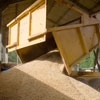Cereals industry burdened by unnecessary costs

A combination of inefficient haulage, unnecessary repeat testing of grain and a failure to collaborate on industry problems is continuing to add to the arable industry’s cost structure, says a new study.
The Cereals Industry Forum has identified five key areas for improvement in cereal supply chains, announced at this week’s CIF conference in London.
Unnecessary multiple grain testing, fragmented haulage operations, a lack of effective communication or collaboration, little product innovation and variations in costs and prices were all areas the arable supply chain needed to scrutinise.
‘Layer-cake approach’
The findings of the three-year CIF study form the basis of the Home Grown Cereals Authority’s Supply Chain Partnership campaign, launched at its annual conference this week
Alastair Dickie, HGCA crop marketing director, said addressing the five key issues would benefit the whole supply chain.
“Despite the concerns of many in the trade, there’s still a ‘layer-cake’ approach to collaboration. It’s often one layer talking to the next one up, or the next one down, but no further.
Hidden costs
“Consequently, the millers don’t know from the farmers what they’re thinking or vice versa – it’s all done through surrogates.”
Examples of the most efficient supply chains in other industries had much greater transparency between parties and resolved competition issues separately, he said.
Duplicate testing of grain added to the industry burden although the cost was often hidden, Mr Dickie added.
Disillusioned
“Every load of wheat that is sold off-farm goes through two or three lab analyses. Someone is paying for that.”
The HGCA was working on a project to sample grain once at harvest, and the cost of testing would subsequently be borne by the merchant or co-operative that buys the grain.
Hauliers were becoming increasingly disillusioned with agricultural work on the back of declining freight rates, long waiting times, poor loading on farms and lengthy turnaround times, Mr Dickie said.
Innovation
Traditionally, millers had chosen to pay more for haulage because it would be cheaper than investing in better facilities. “But a system of time slots for collections and deliveries that was adhered to would remove this costs. Supermarkets insisted on it and it happened,” he said.
Added to this, the food industry was looking for innovation to attract customers, which would provide long-term opportunities for cereals, Mr Dickie added.
“Food consumers are a lot more fickle than they were even ten years ago. They change their minds. New products like foods with a low carbon rating could be developed through farmer collaboration.”
Find out more: Explore each of the CIF findings in more detail. Visit www.hgca.com/supplychain

